Answered step by step
Verified Expert Solution
Question
1 Approved Answer
You are assuming the role of the CEO of the Toronto Zoo, John Smith, in a negotiation in Beijing with the Chinese Association for
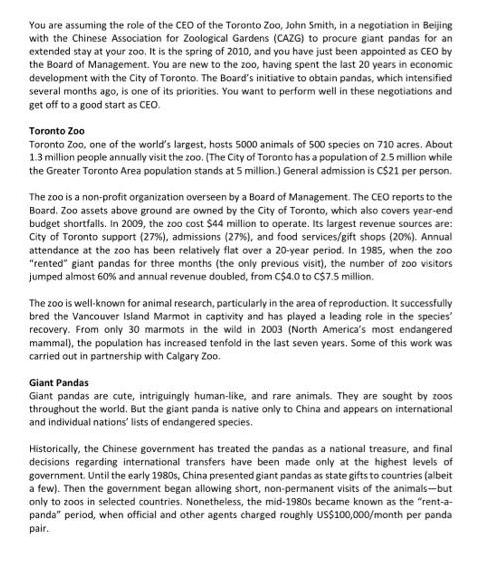
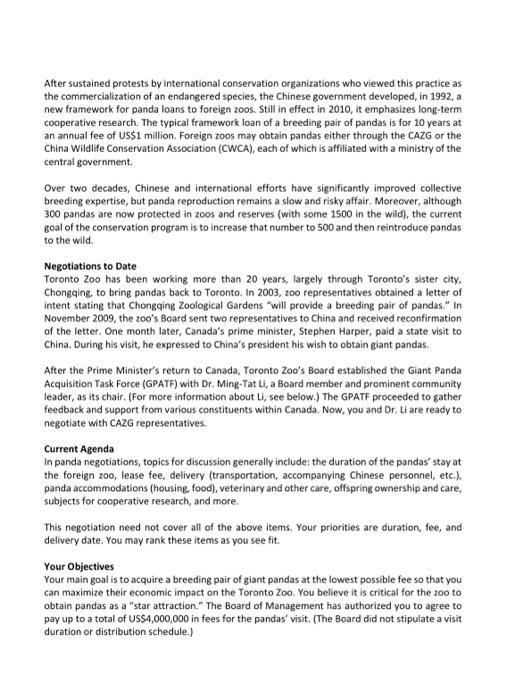
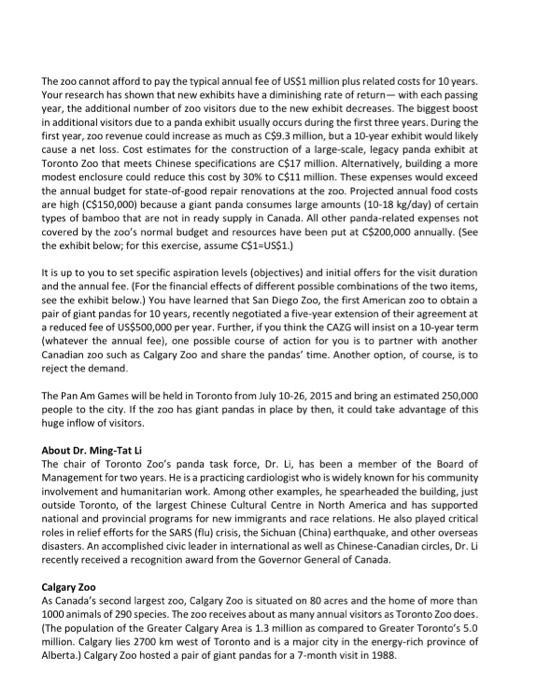
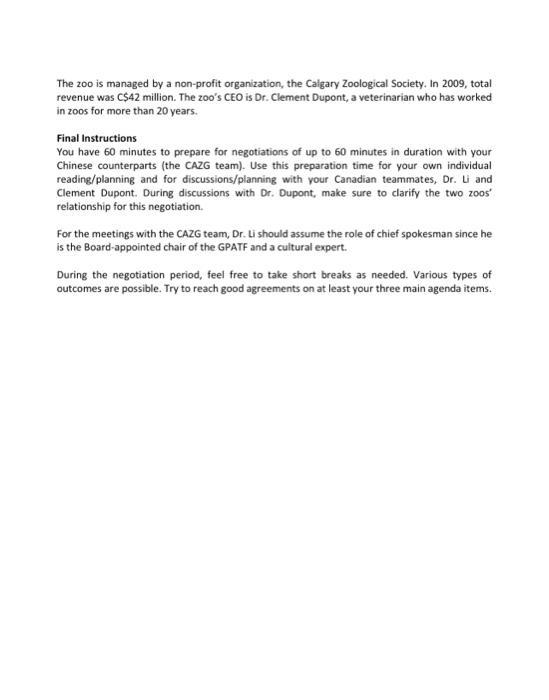
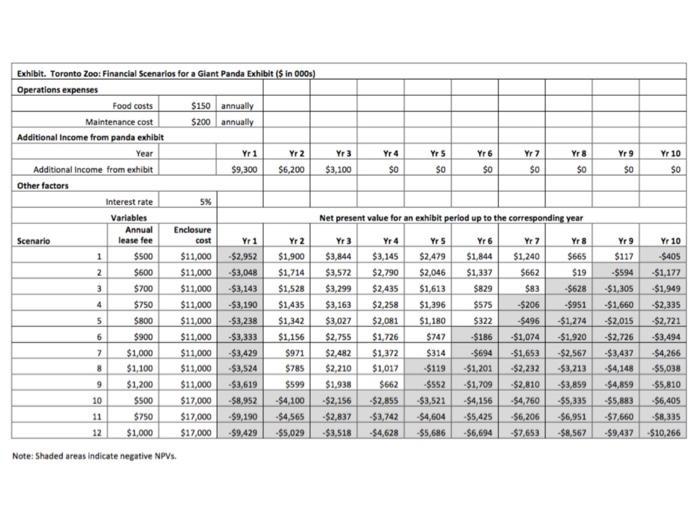
You are assuming the role of the CEO of the Toronto Zoo, John Smith, in a negotiation in Beijing with the Chinese Association for Zoological Gardens (CAZG) to procure giant pandas for an extended stay at your zoo, It is the spring of 2010, and you have just been appointed as CEO by the Board of Management. You are new to the zoo, having spent the last 20 years in economic development with the City of Toronto. The Board's initiative to obtain pandas, which intensified several months ago, is one of its priorities. You want to perform well in these negotiations and get off to a good start as CEO. Toronto Zoo Toronto Zoo, one of the world's largest, hosts 5000 animals of 500 species on 710 acres. About 1.3 million people annually visit the zoo. (The City of Toronto has a population of 2.5 million while the Greater Toronto Area population stands at 5 million.) General admission is C$21 per person. The zoo is a non-profit organization overseen by a Board of Management. The CEO reports to the Board. Zoo assets above ground are owned by the City of Toronto, which also covers year-end budget shortfalls. In 2009, the zoo cost $44 million to operate. Its largest revenue sources are: City of Toronto support (27%), admissions (27%), and food services/gift shops (20%). Annual attendance at the zoo has been relatively flat over a 20-year period. In 1985, when the zoo "rented" giant pandas for three months (the only previous visit), the number of 200 visitors jumped almost 60% and annual revenue doubled, from C$4.0 to C$7.5 million. The zoo is well-known for animal research, particularly in the area of reproduction. It successfully bred the Vancouver Island Marmot in captivity and has played a leading role in the species' recovery. From only 30 marmots in the wild in 2003 (North America's most endangered mammal), the population has increased tenfold in the last seven years. Some of this work was carried out in partnership with Calgary Zoo. Giant Pandas Giant pandas are cute, intriguingly human-like, and rare animals. They are sought by zoos throughout the world. But the giant panda is native only to China and appears on international and individual nations' lists of endangered species. Historically, the Chinese government has treated the pandas as a national treasure, and final decisions regarding international transfers have been made only at the highest levels of government. Until the early 1980s, China presented giant pandas as state gifts to countries (albeit a few). Then the government began allowing short, non-permanent visits of the animals-but only to zoos in selected countries. Nonetheless, the mid-1980s became known as the "rent-a- panda" period, when official and other agents charged roughly US$100,000/month per panda pair. After sustained protests by international conservation organizations who viewed this practice as the commercialization of an endangered species, the Chinese government developed, in 1992, a new framework for panda loans to foreign zoos. Still in effect in 2010, it emphasizes long-term cooperative research. The typical framework loan of a breeding pair of pandas is for 10 years at an annual fee of US$1 million. Foreign zoos may obtain pandas either through the CAZG or the China Wildlife Conservation Association (CWCA), each of which is affiliated with a ministry of the central government. Over two decades, Chinese and international efforts have significantly improved collective breeding expertise, but panda reproduction remains a slow and risky affair. Moreover, although 300 pandas are now protected in zoos and reserves (with some 1500 in the wild), the current goal of the conservation program is to increase that number to 500 and then reintroduce pandas to the wild. Negotiations to Date Toronto Zoo has been working more than 20 years, largely through Toronto's sister city, Chongqing, to bring pandas back to Toronto. In 2003, zoo representatives obtained a letter of intent stating that Chongqing Zoological Gardens "will provide a breeding pair of pandas." In November 2009, the zoo's Board sent two representatives to China and received reconfirmation of the letter. One month later, Canada's prime minister, Stephen Harper, paid a state visit to China. During his visit, he expressed to China's president his wish to obtain giant pandas. After the Prime Minister's return to Canada, Toronto Zoo's Board established the Giant Panda Acquisition Task Force (GPATF) with Dr. Ming-Tat Li, a Board member and prominent community leader, as its chair. (For more information about Li, see below.) The GPATF proceeded to gather feedback and support from various constituents within Canada. Now, you and Dr. Li are ready to negotiate with CAZG representatives. Current Agenda In panda negotiations, topics for discussion generally include: the duration of the pandas' stay at the foreign zoo, lease fee, delivery (transportation, accompanying Chinese personnel, etc.). panda accommodations (housing, food), veterinary and other care, offspring ownership and care, subjects for cooperative research, and more. This negotiation need not cover all of the above items. Your priorities are duration, fee, and delivery date. You may rank these items as you see fit. Your Objectives Your main goal is to acquire a breeding pair of giant pandas at the lowest possible fee so that you can maximize their economic impact on the Toronto Zoo. You believe it is critical for the 200 to obtain pandas as a "star attraction." The Board of Management has authorized you to agree to pay up to a total of US$4,000,000 in fees for the pandas' visit. (The Board did not stipulate a visit duration or distribution schedule.) The 200 cannot afford to pay the typical annual fee of US$1 million plus related costs for 10 years. Your research has shown that new exhibits have a diminishing rate of return- with each passing year, the additional number of zoo visitors due to the new exhibit decreases. The biggest boost in additional visitors due to a panda exhibit usually occurs during the first three years. During the first year, zoo revenue could increase as much as C$9.3 million, but a 10-year exhibit would likely cause a net loss. Cost estimates for the construction of a large-scale, legacy panda exhibit at Toronto Zoo that meets Chinese specifications are C$17 million. Alternatively, building a more modest enclosure could reduce this cost by 30% to C$11 million. These expenses would exceed the annual budget for state-of-good repair renovations at the zoo. Projected annual food costs are high (C$150,000) because a giant panda consumes large amounts (10-18 kg/day) of certain types of bamboo that are not in ready supply in Canada. All other panda-related expenses not covered by the zoo's normal budget and resources have been put at C$200,000 annually. (See the exhibit below; for this exercise, assume C$1=US$1.) It is up to you to set specific aspiration levels (objectives) and initial offers for the visit duration and the annual fee. (For the financial effects of different possible combinations of the two items, see the exhibit below.) You have learned that San Diego Zoo, the first American zoo to obtain a pair of giant pandas for 10 years, recently negotiated a five-year extension of their agreement at a reduced fee of US$500,000 per year. Further, if you think the CAZG will insist on a 10-year term (whatever the annual fee), one possible course of action for you is to partner with another Canadian zoo such as Calgary Zoo and share the pandas' time. Another option, of course, is to reject the demand. The Pan Am Games will be held in Toronto from July 10-26, 2015 and bring an estimated 250,000 people to the city. If the zoo has giant pandas in place by then, it could take advantage of this huge inflow of visitors. About Dr. Ming-Tat Li The chair of Toronto Zoo's panda task force, Dr. Li, has been a member of the Board of Management for two years. He is a practicing cardiologist who is widely known for his community involvement and humanitarian work. Among other examples, he spearheaded the building, just outside Toronto, of the largest Chinese Cultural Centre in North America and has supported national and provincial programs for new immigrants and race relations. He also played critical roles in relief efforts for the SARS (flu) crisis, the Sichuan (China) earthquake, and other overseas disasters. An accomplished civic leader in international as well as Chinese-Canadian circles, Dr. Li recently received a recognition award from the Governor General of Canada. Calgary Zoo As Canada's second largest zoo, Calgary Zoo is situated on 80 acres and the home of more than 1000 animals of 290 species. The zoo receives about as many annual visitors as Toronto Zoo does. (The population of the Greater Calgary Area is 1.3 million as compared to Greater Toronto's 5.0 million. Calgary lies 2700 km west of Toronto and is a major city in the energy-rich province of Alberta.) Calgary Zoo hosted a pair of giant pandas for a 7-month visit in 1988. The zoo is managed by a non-profit organization, the Calgary Zoological Society. In 2009, total revenue was C$42 million. The zoo's CEO is Dr. Clement Dupont, a veterinarian who has worked in zoos for more than 20 years. Final Instructions You have 60 minutes to prepare for negotiations of up to 60 minutes in duration with your Chinese counterparts (the CAZG team). Use this preparation time for your own individual reading/planning and for discussions/planning with your Canadian teammates, Dr. Li and Clement Dupont. During discussions with Dr. Dupont, make sure to clarify the two zoos relationship for this negotiation. For the meetings with the CAZG team, Dr. Li should assume the role of chief spokesman since he is the Board-appointed chair of the GPATF and a cultural expert. During the negotiation period, feel free to take short breaks as needed. Various types of outcomes are possible. Try to reach good agreements on at least your three main agenda items. Exhibit. Toronto Zoo: Financial Scenarios for a Giant Panda Exhibit ($in 000s) Operations expenses Food costs Maintenance cost Additional Income from panda exhibit Year Additional Income from exhibit Other factors Scenario 1 2 3 4 5 6 7 8 9 10 11 12 Interest rate Variables Annual lease fee $500 $600 $700 $750 $800 $900 $1,000 $1,100 $1,200 $500 $750 $1,000 $150 annually $200 annually Note: Shaded areas indicate negative NPVs. 5% Enclosure cost Yr 1 $9,300 Yr 1 $11,000 -$2,952 $11,000 -$3,048 $11,000 -$3,143 $11,000 -$3,190 $11,000 -$3,238 $11,000 -$3,333 $11,000 -$3,429 $11,000 -$3,524 $11,000 -$3,619 $17,000 $17,000 $17,000 -$8,952 -$9,190 -$9,429 Yr 2 $6,200 Yr 3 $3,100 -$4,100 -$4,565 -$5,029 Yr 4 $0 Yr 2 Yr 3 Yr 4 $1,900 $3,844 $3,145 $1,714 $3,572 $2,790 $1,528 $3,299 $2,435 $1,435 $3,163 $1,342 $3,027 $1,156 $2,755 $971 $2,482 $785 $2,210 $599 $1,938 Yr 5 50 Yr 6 $0 Yr 7 $0 Net present value for an exhibit period up to the corresponding year Yr 5 $2,479 $2,046 $1,613 $2,258 $1,396 $2,081 $1,180 $1,726 $1,372 $1,017 $662 -$552 -$2,156 -$2,855 -$3,521 -$3,742 -$4,604 -$2,837 -$3,518 -$4,628 -$5,686 Yr 8 $0 Yr 9 50 Yr 10 50 Yr 6 Yr 7 Yr 8 Yr 9 Yr 10 $1,844 $1,240 $665 $117 -$405 $1,337 $662 $19 -$594 -$1,177 $829 $83 -$628 -$1,305 -$1,949 -$206 -$951 -$1.660 -$2,335 $575 $322 $747 -$186 -$2.721 -$496 -$1,274 -$2.015 -$1,074 -$1,920 -$2,726 -$3,494 $314 -$694 -$1,653 -$2,567 -$3,437 -$4,266 -$119 -$1,201 -$2,232 -$3,213 -$4,148 -$5,038 -$1,709 -$2,810 -$3,859 -$4,859 -$5,810 -$4,156 -$4,760 -$5,335 -$5,883 -$5,425 -$6,206 -$6,405 -$6,951 -$7,660 -$8.335 -$6,694 -$7,653 -$8,567 -$9,437 -$10,266
Step by Step Solution
★★★★★
3.46 Rating (153 Votes )
There are 3 Steps involved in it
Step: 1

Get Instant Access to Expert-Tailored Solutions
See step-by-step solutions with expert insights and AI powered tools for academic success
Step: 2

Step: 3

Ace Your Homework with AI
Get the answers you need in no time with our AI-driven, step-by-step assistance
Get Started


